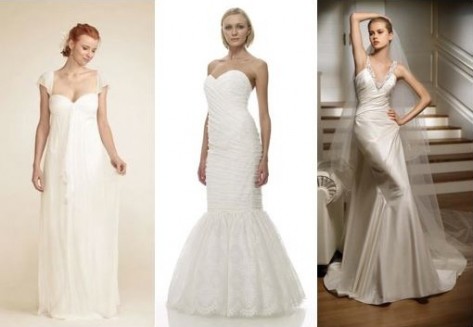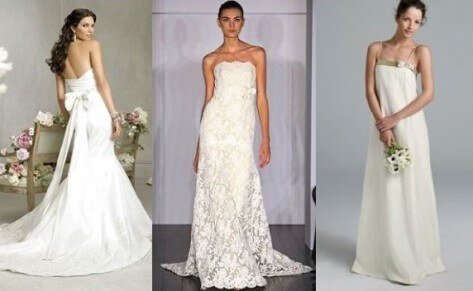One of the best parts of being a bride? Trying on all the gorgeous, dreamy wedding gowns of course! But wedding dress shopping can also be overwhelming with all the different shapes, fabrics, and styles to choose from. Let us help – here is a little breakdown about the most popular fabrics and some of the silhouettes best for them…
Charmeuse:
Charmeuse is the lightest of all satins. It has a glossy finish that drapes and clings to the body. Charmeuse works best in an evening gown or slip dress style. If you are looking for a form fitting sexy dress then Charmeuse is the material for you!
Cotton:
Cotton is a breathable and comfortable fabric. Cotton is not commonly thought of as wedding gown material but it does create very beautiful gowns. It can be very easily manipulated so it can be in an array of dress designs.
Dupioni Silk:
Dupioni silk is thick with a slight sheen and a coarse, knobby finish. Dupioni is a natural pure silk made from double cocoons. Since Dupioni is a thicker fabric, it works best for fuller silhouettes and modified A-line dresses.
xxx
xxx
Duchesse Satin:
Duchesse Satin is a classic wedding gown material. Duchesse Satin is more affordable than pure silk because it is blended with rayon. It has versatility because it works for full as well as straight gowns.
Lace:
Lace is a very delicate and decorative fabric. Lace is typically made from cotton or synthetic materials. Lace is commonly used in wedding gowns as an overlay on top of solid fabrics or even more lace.
Linen:
Linen is typically thought of as a more casual fabric because of its breathability. Linen dresses are common for beach weddings but can also be perfect for a Tahoe wedding. Linen can also be dressed up, depending on the cut and style, and used for more formal gowns.
xxx
xxx
Silk:
Silk is the most common, cherished, and priciest wedding gown fabric. Silk is a smooth natural fiber. Silk threads are also woven in different fashions and combinations to create tons of other fabrics, such as satin, duchesse satin, charmeuse, chiffon, organza, and even tulle.
Taffeta:
Taffeta is crisp, stiff and a light-weave fabric with a slight rib. It can be made from synthetic fibers or pure silk. Taffeta is an ideal choice for ball gowns and A-lines because it adds volume without adding unnecessary weight.
Tulle:
Tulle the traditional material used for bridal veils. Tulle is a fine mesh netting that is made from silk or nylon. Tulle has become popular in bouffant skirts, Vera Wang popularized this ballerina-inspired skirt style.
xxx
xxx
There are hundreds of different wedding gown materials and combinations available. Hopefully this will help begin to simplify choosing the perfect dress for you. The best way to find the “one” is to try on as many gowns as possible!




